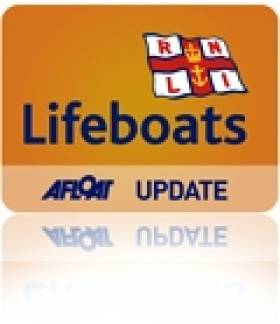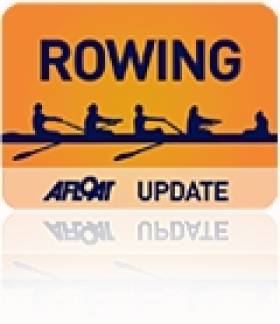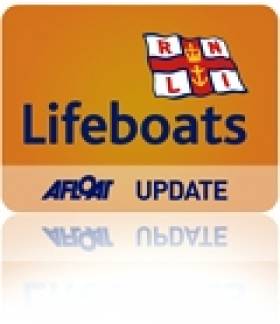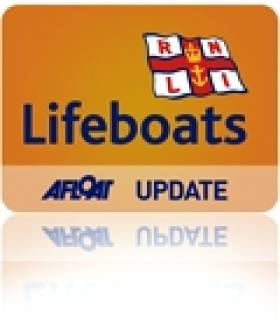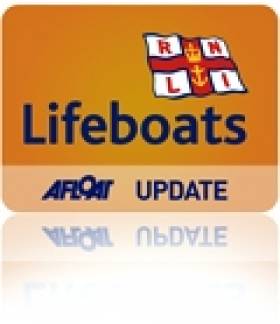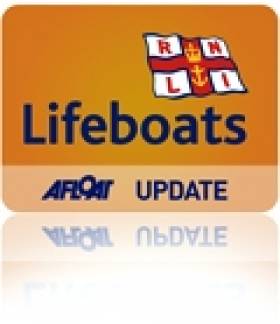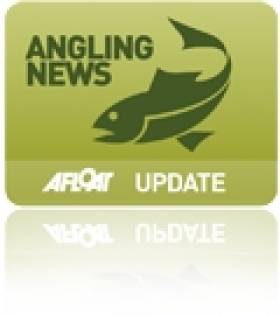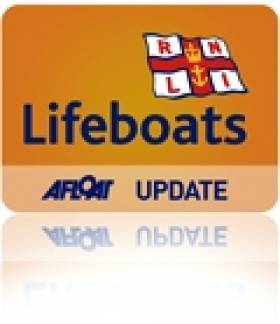Displaying items by tag: Northern Ireland
Larne RNLI Rescues Unconscious Man From Lough
#RNLI - Larne RNLI rescued an unconscious man who was found a short distance from the shore at Larne Lough last night (Thursday 20 June).
The volunteer crew launched their inshore lifeboat Hannahbella Ferguson following a request by Belfast Coastguard at 10.35pm to go to the assistance of a person who was spotted lying face down in the sea within 200 metres from the shore in Larne Lough.
Weather conditions at the time were good with a flat calm sea but light was fading.
The lifeboat - helmed by Willie Evans and with crew members Dave Somerville and Pamela Dorman onboard - arrived on scene at 10.41pm and pulled the casualty on to the lifeboat. With the man not breathing, two crew members proceeded to perform CPR and resuscitated the casualty.
The helm brought the lifeboat into a small slipway along the promenade which was accessible due to a high tide. The casualty was subsequently handed over to the waiting paramedics and ambulance.
Speaking after the call-out, Larne RNLI helm Willie Evans praised the crew who he said had worked together to resuscitate the casualty and bring him to shore.
Portaferry RNLI Rescue Two Men In Drifting Dory
#RNLI - Portaferry RNLI launched on Saturday afternoon 15 June to go to the rescue of a small craft which had lost power in Strangford Lough, Co Down.
The volunteer lifeboat crew was alerted at 1.10pm following a call that there was a 5m Dory drifting after its engine had failed.
The lifeboat - helmed by Simon Rogers and with crew members George Toma, Brendan Byers and Ryan Kelly onboard - was launched at 1.20pm and was alongside the stricken vessel just off Gransha Point at 1.34pm.
The weather at the time was a slight swell, light winds and good visibility.
Once alongside, the lifeboat crew found that the Dory was taking on water. The two men were taken onboard the lifeboat and the Dory was towed into Strangford Lough Yacht Club where the men were also left off.
Reid Lands New Post as Rowing Development Officer
# ROWING: Rowing Ireland has announced the appointment of Gordon Reid as a full time Belfast-based Club and Coach Development Officer.
Reid will be responsible for leading the development and improvement of the Rowing Ireland club development system within Northern Ireland, including delivery of a range of services to support clubs and coaches.
This is a new position and will add to the Coach Education and Club Development work already being done by Pat McInerney, Coach Education Officer.
Reid has been a director of Rowing Ireland, and a board member of the Ulster Branch.
“I am delighted to accept this position with its focus on working with clubs and coaches, and I look forward to helping them to develop skills, systems and to achieve results,” he said.
Hamish Adams, the chief executive of Rowing Ireland, said: “We are delighted to appoint someone of Gordon’s calibre to this extremely important role. Gordon’s administration and practical experience will be an asset to not only the Northern Ireland Club’s but rowing in general.”
Crash With Turbine Caused Strangford Lough Yacht Dismasting
#RNLI - A collision with a tidal turbine was to blame for the incident that caused the dismasting of a yacht in Strangford Lough on Sunday 9 June.
As reported yesterday on Afloat.ie, Portaferry RNLI's lifeboat crew was dispatched to the stricken yacht in the narrows of Strangford Lough close to the SeaGen water turbine.
The local RNLI press office confirmed that three men and a teenage boy were on board the 37ft yacht at the time - though BBC News says that only three people were rescued, including a child.
The SeaGen installation in Strangford Lough was accredited by Ofgen as Britain's first tidal power plant, as previously reported on Afloat.ie.
#RNLI - Enniskillen RNLI today (10 June) brought four people to safety in two separate incidents on Lough Erne in Co Fermanagh.
In the first call-out of the day, the volunteer lifeboat crew retrieved a man and women from their stranded cruiser which had developed engine problems and run aground on Lower Lough Erne.
The inshore lifeboat Joseph and Mary Hiley and the Rescue Water Craft (RWC) were launched just before 10am at the request of Belfast Coastguard and made the 25-minute, six-mile journey to the casualty's last known position at Crunnish Island. The wind was coming from the south east, force five with good visibility.
On arrival at the scene, the crew noted the casualties had deployed their anchor and there were strong waves hitting the starboard side of the vessel.
The RWC crew member was transferred to the casualty vessel to reassure the crew and to check for any leakage. Another crew member from the lifeboat was transferred to assist with the tow and to lift the anchor.
The lifeboat established a tow and the vessel was refloated and brought to safety at Tudor Farm jetty, close to the initial location.
Less than three hours later, the inshore lifeboat Jason Logg was launched by request of Belfast Coastguard to rescue two people on a broken-down personal water craft on Upper Lough Erne.
The crew proceeded to the casualty's last known whereabouts at the mouth of Tamlagh Bay, four miles downstream from the station towards Enniskillen.
On arrival, the crew found the troubled vessel in the reeds with two people sitting on it. The crew transferred both passengers onto the lifeboat before setting up a tow and bringing the water craft back to Bellanaleck Marina.
Elsewhere in Northern Ireland, Portaferry RNLI brought three men and a teenage boy to safety yesterday afternoon after their yacht got into difficulty off Portaferry in Co Down.
The volunteer lifeboat crew was alerted just after noon following a mayday call that there was a demasted yacht in trouble on Strangford Lough.
The lifeboat was launched minutes later and was alongside the stricken vessel, a 37ft yacht located in the narrows of Strangford Lough, at 12.10pm. Weather at the time was good with clear visibility and a flat calm sea.
One of the four casualties, who had been thrown from the vessel, had been recovered by a fellow crew member and all four were on board the yacht when the lifeboat crew arrived on scene.
Alongside, there was difficulty recovering the vessel so the mast and sail were cut away. Once cut, the lifeboat proceeded to tow the yacht with it crew on board safely back to Strangford where it was tied to a mooring.
Two of the crew were conveyed to hospital while the other two were made comfortable on the shore.
Portaferry RNLI was requested to launch for a second time later this afternoon following a report that a swimmer had gone missing in Newtownards. The lifeboat having launched was subsequently stood down after the missing person was found safe and well.
Stranraer RNLI Rescues North Channel Drifters
#RNLI - Stranraer RNLI's lifeboat was dispatched by Belfast Coastguard on Friday evening (7 June) to rescue men from a stranded personal water craft on the rocks at Corsewall Point.
The men had been travelling on the water scooter across the North Channel from Ballycastle in Northern Ireland to Campbeltown in Scotland and back - a round trip of some 130km - but ran out of fuel on the return leg, and drifted to Corsewall on the north point of the Rhins of Galloway.
The RNLI Stranraer lifeboat launched at 5.20pm from Lady Bay and 20 minutes later arrived on scene, where they discovered that two of the men were cold and one had an ankle injury - although a conflicting report via the Belfast Coastguard says only two men were found.
The men were transferred safely on to the lifeboat and taken to Dally Bay, from where they were taken by road to Stranraer Accident and Emergency Hospital.
But as BBC News reports, they were beset by further problems on their return trip to Northern Ireland later that evening, when the private vessel on which they were travelling also ran out of fuel and had to be towed to Red Bay in Co Antrim.
Belfast Coastguard confirmed to the BBC that the men had been travelling on their water scooter with "no navigational aids" and that "they could not get a signal from their mobile phone".
Larne Lifeboats In Two Separate Call-Outs
#RNLI - Larne RNLI was called out for assistance on two separate occasions this past week.
On Thursday night 6 June, the volunteer lifeboat Dr John McSparran responded to a request by Belfast Coastguard to assist a lone yachtsman who had become disorientated in sea fog.
Weather conditions at the time were described as flat calm with no wind at all. However, a sea fog had come down in the evening, and the man on board - having left Girvan in Scotland en route to Glenarm Marina in an old gaffer to celebrate the Old Gaffers Association's Golden Jubilee - got into difficulty.
The casualty was located becalmed seven miles east of The Maidens Lighthouse. Lifeboat crew members Martin Agnew and Scott Leitch were put on board to assist after it was discovered that the casualty's outboard engine had failed and the gaffer was making no headway against the tide.
It was decided by Coxswain Frank Healy to tow the casualty to Glenarm, keeping the two crew members on board to assist. The vessels and crews arrived in Glenarm at 1.30am.
Two nights before, Larne RNLI assisted two men after their motor boat got into difficulty on Belfast Lough.
The volunteer crew launched their inshore lifeboat, the Hannahbella Ferguson, at 8.15pm following a request to assist the speed boat which had sustained engine failure off Muck Island.
Two men, both wearing lifejackets, were on board. Weather conditions at the time were described as good with a flat calm sea.
The casualty boat was subsequently towed safely to shore by the lifeboat to Portmuck Harbour.
Crew on this call out included helm Willie Evans, Martin Agnew and Jay Torbitt.
#Oil&Gas - The public consultation on the first stage of environmental assessment for developing an oil and gas licensing framework in Northern Ireland's inland waters continues till next Friday 14 June.
The 'Scoping Report' was issued on 24 April last by Northern Ireland's Department of Enterprise, Trade and Investment (DETI) and marks the first step of the EU-mandated Strategic Environmental Assessment (SEA) process.
The current consultation seeks comments on the appropriateness of the proposed scope of the SEA and the proposed assessment methodology.
Anti-fracking campaigners Good Energies Alliance Ireland (GEAI) argue that any future oil and gas exploration or extraction in Belfast Lough or Larne Lough would include horizontal drilling and franking.
With one week left to go, GEAI is among those urging the public to have their say in the consultation, citing the 1,300 submissions received by the EPA that the group claims it encouraged on a proposed franking research study.
Northern Ireland has four existing petroleum licences across three main areas of exploration in Antrim, Fermanagh and Derry.
#Angling - From today 1 June, Northern Ireland's anglers are banned from selling salmon caught in rivers under new measures from the Legislative Assembly.
As BBC News reports, Minister for Culture, Arts and Leisure Carál Ní Chuilín said that the new rules are "the first step in a series of conservation measures aimed at protecting stocks of the iconic Atlantic salmon".
The rod and line catch sale ban is intended to encourage the practice of 'catch and release' which is set to become mandatory next year, and also brings NI legislation into line with the rest of Britain and the Republic of Ireland.
It comes months after the shocking news that just three out of every 100 wild salmon returned to Northern Ireland's rivers in 2011, prompting concerns that the species has declined to "Dodo levels".
Moves have already been made to control the commercial offshore netting of salmon in order to boost their numbers in the North's waterways.
Another threat to salmon numbers is the rise of invasive species in Northern Ireland's waterways, which as the News Letter reports have cost the economy more than £46 million a year, according to Environment Minister Alex Attwood.
Highlighting the risk to NI's marine wildlife and plantlife, as well as fisheries and agriculture, the minister said "increasing awareness of the threat of invasive species and the need to tackle them is key to achieving success".
A new strategy by the Legislative Assembly will involve partnerships between government, the community and environment groups "working in tandem" to deal with the problems caused by invasive species such as the Japanese sea squirt, detected in Strangford Lough last year.
New Lifeboat Station For Upper Lough Erne
#RNLI - Enniskillen RNLI is to get a new lifeboat station at its Carrybridge base on Upper Lough Erne, it has emerged.
Planning permission for the new build has been passed by Fermanagh District Council and the RNLI’s tendering process is now underway, with a view for building work to commence in late summer.
Once complete, the modern station - much like the new facility for Castletownbere RNLI that opened recently - will replace the existing temporary accommodation which has housed the charity’s volunteer lifeboat crew for the past 11 years.
In order to facilitate the project, the local community is being asked to help the RNLI raise £60,000 (€70,000) towards the cost, which will help Enniskillen RNLI continue to save lives on Lough Erne.
In 2001, Enniskillen became home to the RNLI’s first inland lifeboat station based on Lower Lough Erne.
Due to the overall size and complexity of the lough and its high leisure usage, the decision was taken by the RNLI in 2002 to base a second lifeboat on the upper lough that would work in conjunction with the original lifeboat station on the lower lough.
With two bases, two inshore lifeboats and two rescue water craft, the station has since proved to be one of the busiest in Ireland.
Last year alone, Enniskillen RNLI launched 46 times bringing 50 people to safety. Some 20 of those services were carried out in the dark while the crew spent 169 service hours on the water.
RNLI divisional operations manager Gareth Morrison said he was delighted that planning had now been approved making way for what will be a purpose-built station in a location close to the lough allowing for an efficient launch.
"In an area that receives over 100 days of heavy rainfall a year, it is hard to believe the volunteer crew based at the upper lough operate from just a temporary facility, partly exposed to the elements," said Morrison.
"The crew has to change in a small, damp, metal container and only has a portaloo and wash basin for their comfort. There is nowhere for the crew to shower or dry after a challenging rescue and nowhere for them to gather and train together during the week.
"We want to build a modern station with full crew facilities with areas for the crew to change and train and space to keep their lifeboat and rescue water craft and lifesaving kit safe."
Enniskillen RNLI lifeboat operations manager Davey Robinson said a new station was what the crew deserved.
"At the moment we are operating out of a temporary facility. It is cramped and there are no showers so the crew cannot warm up after a cold, wet and tiring rescue. A new station will be great for the crew. We are a busy station so it is what they deserve."
He added: "It is always reassuring for locals and visitors alike that the RNLI is here to assist them or help their loved ones when they get into difficulty. We try to act as a safety net on Lough Erne and are here 24 hours a day. But we need the right facilities to do that and this new station will help."
Donations and other assistance with fundraising are welcome. For details contact Tony Hiney, RNLI community fundraising manager, at 087 219 8917 or email [email protected].



























